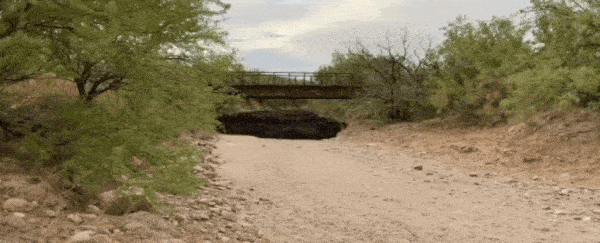On 15 July 2020, what looked like your typical dry waterway was engulfed by a sickening dust puffing black sludge, reminiscent of the villainous cartoon toxin, Hexxus from FernGully: The Last Rainforest.
The Cañada del Oro Wash in Arizona became choked with this monstrosity - known as a sediment slug - after what officials said was a minor storm, while the Bighorn Fire raged nearby.
An ominous video posted by the Pima County officials on Twitter, filmed by a former employee, captured the fast-moving sludge, dark with ash and soot.
Who had this on their 2020 hellscape bingo card? pic.twitter.com/fUNvIVS7aw
— Official Pima County (@pimaarizona) July 16, 2020
The debris fuelling the Bighorn Fire was thought to have been ignited by lightning; the fire has engulfed over 48,377 hectares (119,541 acres) of national park since June 5 in a region that covers diverse ecosystems from saguaro cactus stands to pine and fir forests. While it's been brought under control, the fire is still burning the foothills of the Catalina mountains.
As if wildlife doesn't have enough to contend with after fires scorch their landscape, fires make future rains dangerous, too.
"Wildfires like the Bighorn Fire leave the ground charred, barren, and unable to absorb water," Pima County officials wrote on Twitter. "Even a light rain can produce devastating flash floods and mudflows, often with little warning."
Fire changes the structure of the soil by mineralising organic matter and releasing nutrients, metals, and toxins that usually aren't free to be swept away by water. The new soil structure then repels water.
"It takes much less rainfall to trigger debris flows from burned basins than from unburned areas," USGS's California Water Science Center explains. "In Southern California, as little as 7 millimetres (0.3 inches) of rainfall in 30 minutes has triggered debris flows."
With the loss of vegetation holding the soil in place, the ash and loose earth end up smothering waterways. This reduces dissolved oxygen levels, while increased nutrients allow cyanobacteria to grow and algae to bloom, which take up even more of the oxygen.
The eventual lack of oxygen suffocates fish, crabs and other waterway wildlife, leading to mass deaths like those seen after Australia's unprecedented 2019-2020 summer of bushfires.
If the fish and other wildlife somehow survive all that, they may then starve to death, unable to see their food as the clouded water reduces visibility, and starves aquatic plants and algae of the light they need to photosynthesise.
Sediment slugs can also ooze their way into dams and threaten our drinking water, making mud too thick for filtration systems to cope with.
When large solid debris also joins the fast-moving sludge, it contributes to the erosion of anything in the way of the flow, including destabilising roads and paths, and posing risk to water treatment infrastructure.
"Fast-moving, highly destructive debris flows triggered by intense rainfall are one of the most dangerous post-fire hazards. Such debris flows are particularly dangerous because they tend to occur with little warning," explained a USGS in a report.
"Debris flows can strip vegetation, block drainages, damage structures, and endanger human life."
Ecologist Paul McInerney from CSIRO and colleagues explained in an article on The Conversation that using sediment barriers and other erosion control measures may be able to limit the size of these sediment slugs. Ensuring waterways are re-vegetated can also help in the long term.
But these events can lead to decades of impact. In some cases fish populations never recover, ecologist Lee Baumgartner told The Guardian, pointing to 1939 bushfires that destroyed fish populations in Australia's Lachlan River.
Of course, limiting wildfire-fuelling climate change would be the ultimate way of reducing the occurrence of such slimy sediment slugs. But perhaps, like Hexxus, we're just too in love with our toxic sludge.
